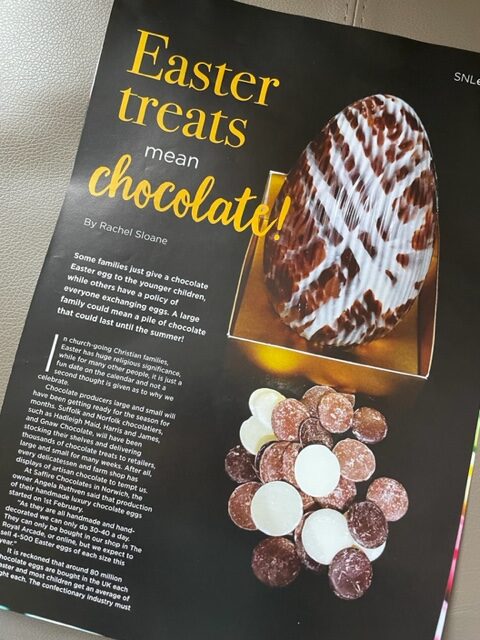Easter Treats means chocolate!

Some families just give a chocolate Easter egg to the younger children, while others have a policy of everyone exchanging eggs. A large family could mean a pile of chocolate that could last until the summer! In church-going Christian families, Easter has huge religious significance, while for many other people, it is just a fun date on the calendar and not a second thought is giving as to why we celebrate.
Chocolate producers large and small will have been getting ready for the season for months. Suffolk and Norfolk chocolatiers, such as Hadleigh Maid, Harris and James, and Gnaw Chocolate, will have been stocking their shelves and delivering thousands of chocolate treats to retailers, large and small for many weeks. After all, every delicatessen and farm shop has displays of artisan chocolate to tempt us.
At Saffire Chocolates in Norwich, the owner Angela Ruthven said that production of their handmade luxury chocolate eggs started on 1st February.
“As they are all handmade and hand-decorated we can only do 30-40 a day. They can only be bought in our shop in The Royal Arcade, or online, but we expect to sell 4-500 Easter eggs of each size this year.”
It is reckoned that around 80 million chocolate eggs are bought in the UK each Easter and most children get an average of eight each. The confectionary industry must be very glad of this boost, coming just after we have all forgotten the culinary indulgences of Christmas and Valentines Day.
So where does the tradition of giving chocolate eggs come from?
Early Christians combined spring pagan rituals with the Bible story and, as eggs are a sign of fertility and rebirth, an obvious connection can be made with Jesus’ s resurrection on Easter Sunday. Some also say the hollow egg represents the cave that his body was placed in, prior to the resurrection.
In the Middle-Ages the tradition began of giving hard-boiled eggs, coloured in boiling water with natural dyes, or hand-painted as gifts, to mark the end of Lent, a tradition that has endured in some countries.
Chocolate eggs first appeared in France and Germany, then the first British hollow chocolate eggs were produced in 1873 by Fry’s, with Cadbury’s following soon after. The tradition, popular in Victorian times, of giving hollow papier-mâché or cardboard eggs, filled with treats, has reappeared in more recent times, with many of our craft shops and farm shops selling them.
The style of the Easter eggs we buy has continued to develop. First the mass-produced chocolate eggs were decorated with marzipan or icing, then extra sweets were put in a small bag inside the hollow chocolate shell and, more recently, presumably to make production easier, the extra sweets are found in the presentation box rather than the egg itself.
The cardboard box that a hollow chocolate egg is packaged in, is a feat of engineering, enabling a quite fragile egg to safely be transported and displayed on a shop shelf, then carried in one piece to our homes. A 1950’s carton designer, William T Horry, used the design of a lightbulb box to come up with the first Easter Egg box, and it was used for a Roses Easter Egg.
In 1925 Cadbury had 14 versions of egg and Fry’s had 50 (they merged in 1973) and now, Cadbury’s proudly say over 500 million Creme Eggs are made every year with about two thirds of that number being enjoyed in the UK. That is 3.5 Cadbury Creme Eggs for every person in this country to enjoy! Cadbury is the number one brand at Easter, with 20% total of sales, followed by 8% sales of Nestle, with Haribo close by with 5% sales. Every year over 80 million boxed chocolate shell eggs are sold, and we spend £150 million on shell eggs, £70 million on creme filled eggs and £30 million on mini eggs. It is a huge industry.
The big supermarkets with their multibuy deals mean that the price of the chocolate eggs has come down, but surely the cost of an Easter Egg per gram must be more expensive that buying an equivalent bar of chocolate? Probably, but I think we’d all agree it just isn’t the same!
If we are going to buy chocolate this Easter, perhaps we should support our local specialist chocolate makers? Children might like to count their haul, but for the adults in our life perhaps one or two luxury chocolate Easter Eggs would be appreciated more than eight eggs costing a pound or two each? Handmade artisan products may more expensive, but the quality and taste is so good… and we will be supporting local businesses, both the makers and the smaller retailers.
Writing this article has made me long for some chocolate, so I am sorry if reading it has had the same effect on you! Of course, if you are watching your waistline, you could, rather than give chocolate eggs, go for gifts that reflect the other Easter traditions …. Anyone for a decorated hard-boiled egg, a fluffy toy rabbit or a new hat, aka an Easter Bonnet?
Happy Easter!
(This article was first published in Suffolk Norfolk Life magazine in April 2023)